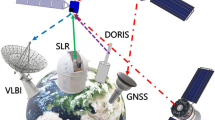Abstract
The operational monitoring of radiation conditions in different orbits in near-Earth space is crucial for ensuring the radiation safety of space flights. The intensity of ionizing radiation fluxes in near-Earth space varies within several orders of magnitude. Therefore, existing averaged empirical models cannot always be used to estimate specific radiation conditions in orbits. The forecast of solar cosmic rays is even less reliable. This paper presents a version of the global system of radiation monitoring in near-Earth space based on the system of multiple small satellites. The considered system of satellites with identical radiometric equipment will provide operational information on the fluxes of electrons and protons of Earth radiation belts and solar cosmic rays, which will make it possible to create 3D pictures of the distribution of particle fluxes in real time.
Similar content being viewed by others
References
Novikov, L.S. and Panasyuk, M.I., Studies of cosmic radiation and its impact on the materials and equipment of spacecrafts, Vopr. At. Nauki Tekh., Ser.: Fiz. Radiats. Vozdeistv. Radioelektron. Appar., 2002. no. 4, p. 3–13.
Sawyer, D.M. and Vette, J.I., AP-8 trapped proton environment for solar maximum and solar minimum, NSSDC/WDC-A-R&S 76-06, 1979.
Vette, J.I., The AE-8 trapped electron environment, NSSDC/WDC-A-R&S 1-24, 1991.
Ginet, G.P., O’ Brien, T.P., Huston, S.L., et al., AE9, AP9 and SPM: New models for specifying the trapped energetic particle and space plasma environment, Space Sci. Rev., 2013. vol. 179, nos. 1–4, pp. 579–615.
Panasyuk, M.I. Sosnovets, E.N., et al., The Earth’s natural radiation belts, in Model’ kosmosa (Cosmic Model), Moscow: MGU, 1983. vol. 3, p. 66–91.
Panasyuk, M.I. and Sosnovets, E.N., Intensities of electrons and protons as a function of L and B, in Model’ kosmosa (Cosmic Model), Moscow: MGU, 1983. vol. 3, p. 421–531.
Getselev, I.V., Gusev, A.A., Darchieva, L.A., et al., Model’ prostranstvenno-energeticheskogo raspredeleniya potokov zakhvachennykh chastits (protonov i elektronov) v radiatsionnykh poyasakh Zemli, (Model of the Spatial and Energy Distribution of Fluxes of Captured Particles (Protons and Electrons) in the Earth’s Radiation Belts), Moscow: MGU, 1991.
Getselev, I.V., Sosnovets, E.N., Kovtyukh, A.S., et al., An empirical model of the radiation belt of helium nuclei, Cosmic Res., 2005, vol. 43, no. 4, p. 229–232.
GOST 25645.138-86. The Earth’s Natural Radiation Belts. Model of Spatial and Energy Distribution of Proton Flux Density. Moscow, 1986.
GOST 25645.139-86. The Earth’s Natural Radiation Belts. Model of Spatial and Energy Distribution of Electron Flux Density. Moscow, 1986.
OST 134-1044-2007. Hardware, Instrumentation, Facilities, and Equipment of Spacecrafts. Methods for calculation of radiation conditions on board space vehicles and determination of requirements on the resistence of space vehicle electronic radio equipment to naturally occurring charged particles in the cosmos. M.: Roscosmos, 2007.
Tverskaya, L.V., Balashov, S.V., Veden’kin, N.N., et al., Outer radiation belt of relativistic electrons during the minimum of the 23rd solar cycle, Geomagn. Aeron. (Engl. Transl.), 2012, vol. 52, no. 6, p. 740–745.
Gorchakov, E.V., Afanas’ev, V.G., Afanas’ev, K.G., et al., Study of fast charged particles using a Cherenko detector onboard the Kosmos-900 artificial earth satellite, Izv. Vyssh. Uchebn. Zaved., Fiz., 1987. no. 10, p. 69–74.
Mullen, E.G., Gussenhoven, M.S., Ray, K., and Violet, M.A., A double-peaked inner radiation belt: Cause and effect as seen on CRRES, IEEE Trans. Nucl. Sci., 1991. vol. 38, p. 1713–1718.
McIlwain C.E., Magnetic coordinates, Space Sci. Rev., 1966, vol. 5, no. 5, p. 565–584.
Getselev, I.V., Tulupov, V.I., and Shcherbovskii, B.Ya., An instrument for radiation control onboard spacecrafts, Vopr. At. Nauki Tekh., Ser.: Fiz. Radiats. Vozdeistv. Radioelektron. Appar., 2006. nos. 3–4, pp. 89–91.
Author information
Authors and Affiliations
Corresponding author
Additional information
Original Russian Text © M.I. Panasyuk, M.V. Podzolko, A.S. Kovtyukh, I.A. Brilkov, N.A. Vlasova, V.V. Kalegaev, V.I. Osedlo, V.I. Tulupov, I.V. Yashin, 2015, published in Kosmicheskie Issledovaniya, 2015, Vol. 53, No. 6, pp. 461–468.
Rights and permissions
About this article
Cite this article
Panasyuk, M.I., Podzolko, M.V., Kovtyukh, A.S. et al. Operational radiation monitoring in near-Earth space based on the system of multiple small satellites. Cosmic Res 53, 423–429 (2015). https://doi.org/10.1134/S0010952515060039
Received:
Published:
Issue Date:
DOI: https://doi.org/10.1134/S0010952515060039




